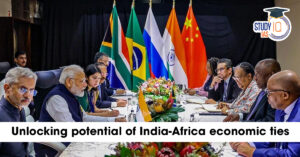Table of Contents
The BRICS nations — Brazil, Russia, India, China, and South Africa — have taken a major step toward financial independence with the launch of BRICS Pay, a revolutionary cross-border payment system aimed at reducing dependence on the U.S.-dominated SWIFT network.
The move reflects the group’s ambition to reshape the global financial architecture, enhance local-currency trade, and create a multipolar world order less vulnerable to Western sanctions.
Background: The Rise of a Multipolar Financial System
The idea of BRICS Pay stems from the long-standing aspiration to de-dollarize global trade.
Western sanctions, especially those imposed on Russia in 2014 and 2022, exposed how the U.S. can leverage SWIFT to control international financial transactions.
In response, BRICS countries began developing independent financial institutions and payment systems, paving the way for a self-reliant alternative.
Evolution of BRICS Financial Cooperation
-
Fortaleza Summit 2014: Creation of the New Development Bank (NDB) and the Contingent Reserve Arrangement (CRA) — the first global institutions led by emerging economies.
-
Post-2015: After sanctions on Russia, BRICS intensified efforts for local currency trade and currency swap mechanisms.
-
Kazan Summit 2024: Formal launch of BRICS Pay, emphasizing the need for a cross-border payment system that supports local currency settlements and strengthens financial sovereignty.
What is BRICS Pay?
BRICS Pay is a cross-border digital payment system designed to facilitate international transactions among member nations using local currencies instead of the U.S. dollar.
Its primary goal is to bypass SWIFT, a Belgium-based system controlled by Western powers, and create an independent financial infrastructure that is secure, fast, and sanction-proof.
The system’s prototype was successfully demonstrated in Moscow (October 2024) by the BRICS Payment Task Force (BPTF).
Technological Framework: The BRICS Digital Backbone
Each BRICS member already operates an advanced digital payment platform:
| Country | System |
|---|---|
| India | Unified Payments Interface (UPI) |
| China | Cross-Border Interbank Payment System (CIPS) |
| Russia | System for Transfer of Financial Messages (SPFS) |
| Brazil | Pix Instant Payment System |
| South Africa | SAMOS (South African Multiple Option Settlement) |
These platforms together form the technological backbone of BRICS Pay, ensuring interoperability, transparency, and high transaction efficiency across borders.
Strategic Objectives of BRICS Pay
-
Financial Sovereignty:
Reduce dependence on the U.S. dollar and Western-controlled financial institutions. -
Economic Efficiency:
Lower transaction costs, accelerate settlements, and promote intra-BRICS trade. -
Geopolitical Autonomy:
Strengthen the bloc’s collective bargaining power in the global economy.
The inclusion of Iran in BRICS (2024) — a country heavily sanctioned by the West — further reinforced the bloc’s intent to build a sanction-resistant payment network.
Challenges Facing BRICS Pay
While promising, BRICS Pay faces several operational and geopolitical challenges:
-
Divergent National Interests: Members prioritize their own systems globally (e.g., India’s UPI, China’s CIPS).
-
Technical Interoperability: Integrating diverse payment systems with common standards is complex.
-
Currency Coordination: Absence of a common BRICS currency complicates exchange mechanisms.
-
Trust Deficit: Concerns persist over China’s growing influence and digital dominance.
Despite these obstacles, the project marks a historic effort toward financial decolonization in the 21st century.
Global Implications
If implemented successfully, BRICS Pay could transform the global financial landscape by:
-
Offering a credible alternative to SWIFT for developing nations.
-
Promoting local currency settlements in trade and energy transactions.
-
Challenging the U.S. dollar’s global monopoly.
-
Encouraging regional cooperation in Asia, Africa, and Latin America.
Even partial adoption of BRICS Pay could signify a paradigm shift toward a more equitable and multipolar global economy.
Conclusion
BRICS Pay represents more than just a payment platform — it is a symbol of financial sovereignty and a bold step toward rewriting the rules of global finance.
By leveraging technology, political unity, and economic synergy, the BRICS nations aim to build a fairer global financial order — one that reflects the aspirations of the Global South.
Its success will depend on trust, integration, and sustained collaboration, but one thing is clear: the age of unilateral financial dominance is slowly giving way to a new multipolar era.


 Micrometeoroids: Tiny Space Particles, M...
Micrometeoroids: Tiny Space Particles, M...
 India Needs a National Insolvency Tribun...
India Needs a National Insolvency Tribun...
 Unlocking the Potential of India–Afric...
Unlocking the Potential of India–Afric...

























